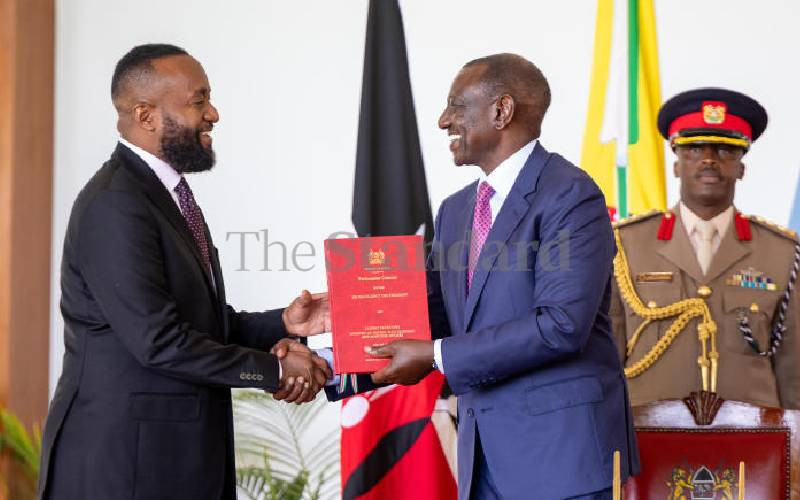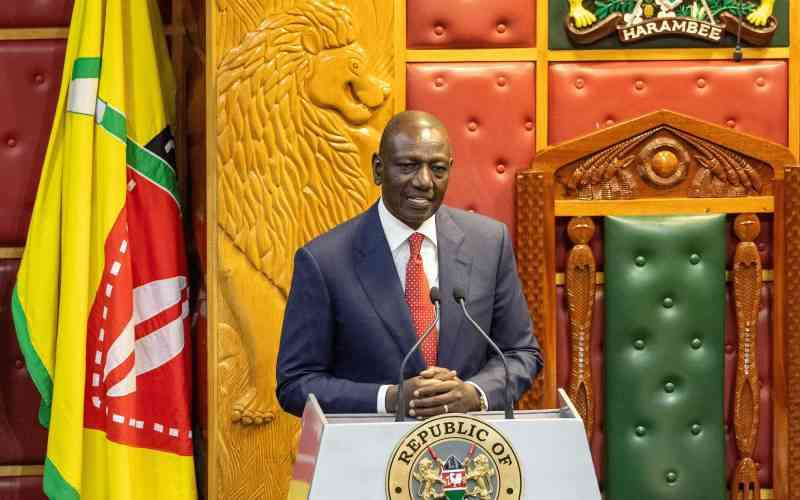
If ever there was a week for President William Ruto and his Kenya Kwanza administration to demonstrate that they are as interested in governance—the “doing of the what” – as they obsessed and excited about politics – who gets to do what – it was the week ending November 22.
As we all know, public participation on proposed tax amendments began on November 18. Cabinet Secretaries signed performance contracts on November 19.
Public hearings on sectoral submissions towards next year’s 2025/26 national budget run from Wednesday to Friday. The President delivered his State of the Nation address on Thursday.
This is not the endless circus of political promises to hordes of the rural unemployed from sunroofs of fuel guzzlers. This is what a proper governance diary might begin to look like to the President.
Of course, it would still be performative optics, and, as church leaders have said, what Kenyans are interested in is more action and less words. But it elevates debate from style to substance. If, say, the President popped into those tax and budget related hearings without advance warning, and offered comments as a “participant”, it helps to show that he can be a “hands-on” listener.
The sector budget public hearings begin today. Before we go there, some quick questions as I follow the performance contracting event while crafting this column. Two simple ones first.
Will these performance contracts be made public because these officers (CSs) ultimately serve the public? Was there an evaluation of the previous round of performance contracts, and is it public?
- Ruto remains mute as healthcare crisis worsens
- Government calls on KMPDU to end strike
- Ruto meets KMPDU officials, promises lasting solutions to end industrial strikes
- Ruto forms a 20-member team to audit healthcare resources
Keep Reading
Two harder ones. Do we now have publicly available Bottom- Up Economic Transformation Agenda (BETA)-driven ministerial strategic plans across all of government which flow seamlessly into the budgets that presumably inform these performance contracts?
Assuming they are linked to budgets (2024/25 in this case), why are these contracts being signed almost six months into the actual budget year? Food for thought. Remember, this administration took all of 18 months to translate its manifesto into a proper plan.
Back to the sector hearings. This is the budget step that follows the Budget Review and Outlook Paper (BROP), which sets resource ceilings for our Medium Term Expenditure Framework (MTEF) sectors. At the hearings, each sector presents a three-year performance and budget review (previous three years before current 2024/25) and a three-year (2025/26-2027/28) performance plan and resource (budget) bid.

Although BETA and its value chain approach is built around five sectors, or clusters, for our economic growth and sectoral/institutional planning targets in the Fourth Medium Term Plan, we are still stuck with the traditional 10 MTEF sectors in our budgeting (in the actual budget presentation in June, only “strategic intervention” spending is captured under the 5 BETA sectors)
As an important backdrop to these hearings, one of the promises made following the June/July Gen Z protests was that the government would adopt a zero-based budgeting approach.
Basically every spending item would need to be justified and optimised from zero. For this reason, BROP only set out resource ceilings after “zero-base” engagement between Treasury and sectors/ministries.
In theory, a rationalised budget for national government. What do the sector reports – which exclude the Judiciary that prepares its own report and holds separate public hearings – tell us?
Let’s begin with aggregates. The draft BROP – without sector ceilings - envisaged 2025/26 national government spending of Sh2.44 trillion before the “zero-base” consultations. The final BROP – with sector ceilings after “zero-base” consultations – raised this to Sh2.62 trillion.
Put simply, at aggregate level the zero-based budgeting promise was “hot air”. The more complex view, as argued by some, is it’s the composition, not size of the budget we need to address. It is instructive that last year’s aggregate ceiling for the current 2024/25 fiscal year was Sh2.55 trillion.
Here is where it really goes haywire. Despite all the jazz about “BROP sector ceilings” and “zero-based budgeting”, the 10 sectors of which nine have reports (national security, NIS and the military do not participate in this process) are walking into these hearings with a total resource bid or requirement of Sh4.5 trillion.
Let’s place this number in perspective. This is Sh1.88 trillion in resource bids above the overall ceiling. In a context in which the TOTAL national budget including counties, CFS/debt service/pensions and contingencies is Sh4.33 trillion.
To be clear, the programmes and projects presented to the public this week are based on a resource bid of Sh4.5 trillion, not ceiling of Sh2.62 trillion.

So the public is being told, “this is what national government plans to do, but resources allow only 58 per cent to be done”. There is something wrong with this casino-like process of speculative, unrealistic, resource bidding.
If we think about it, this is where budgeted corruption begins, since the 58 per cent to be done doesn’t necessarily represent public priorities (or BETA/plans), but the “juiciest” parts of spending regardless of what goes into the actual budget the following June.
For the record, this is the third consecutive year in which sector resource bidding – which to be clear is not actual money - under this administration has exceeded Sh1.7 trillion; the highest ever under Jubilee was Sh1.1 trillion.
The fact of the matter is, at aggregate level, these hearings are about plans which exceed resources by an astonishing 72 per cent instead of restricting the plans to the 58 per cent of resource need they are allocated. This is a big part of our planning-budgeting-results disconnect.
There are no “good guys” here. The overbid by Health sector is 269 per cent (Sh362 billion). It is 190 per cent (Sh119 billion) for General Economic and Commercial Affairs; 140 per cent (Sh110 billion) for Social Protection, Culture and Recreation; 95 per cent (Sh481 billion) for Energy, Infrastructure and ICT; 90 per cent (Sh119 billion) for Environmental Protection, Water and Natural Resources and 66 per cent (Sh56 billion) for Agriculture, Rural and Urban Development.
The overbidding in the Governance, Justice, Law and Order sector is 65 per cent (Sh175 billion); in Public Administration and International Affairs it is 46 per cent (Sh167 billion) and in Education it is 40 per cent (Sh290 billion). Yes, it isn’t actual money, but this is budget impunity at its best.
And that’s before we get to the fact that every single sector (national security excluded) applied a different ceiling in their sector report to the actual BROP ceiling. At aggregate level, the “sector report ceilings” add up to Sh2.68 trillion, or Sh60 billion more than the actual BROP ceiling!
Does all of this negate the purpose of these hearings? Not at all. The overview I present here offers a “big picture” perspective, but there is still space in each sector hearing session to go beyond these aggregates.
Let the sector leaders explain their past performance and forward plans. Get them to justify their individual programs. Offer insights on policy, program or project gaps or opportunities. And ask hard questions about their more expensive “zero-based budgets”!
This sounds like the sort of public process the President and his team may not want to miss.
 The Standard Group Plc is a multi-media organization with investments in media platforms spanning newspaper print
operations, television, radio broadcasting, digital and online services. The Standard Group is recognized as a
leading multi-media house in Kenya with a key influence in matters of national and international interest.
The Standard Group Plc is a multi-media organization with investments in media platforms spanning newspaper print
operations, television, radio broadcasting, digital and online services. The Standard Group is recognized as a
leading multi-media house in Kenya with a key influence in matters of national and international interest.











